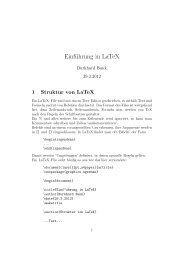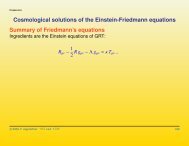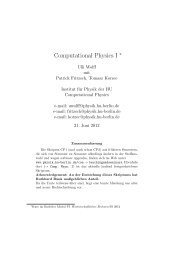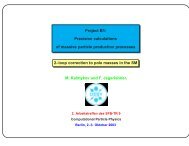Preprint[pdf] - HU Berlin
Preprint[pdf] - HU Berlin
Preprint[pdf] - HU Berlin
Create successful ePaper yourself
Turn your PDF publications into a flip-book with our unique Google optimized e-Paper software.
e + e − → hadrons transition amplitude is proportional to e 2 from the e + e − γ ∗ and the γ ∗ q¯q (hadrons) vertices<br />
which in the cross section appears in quadrature ∝ e 4 or α 2 . Due to the running of the electromagnetic charge<br />
the physical (dressed) cross section is ∝α 2 (s). Undressing requires one to replace the running α(s) by the<br />
classical α:<br />
σ (0)<br />
tot (e+ e − → hadrons) = σtot(e + e − → hadrons)<br />
and, using Eq. (101) we obtain<br />
Π ′ γ(k 2 ) − Π ′ γ(0) = k2<br />
4π 2 α<br />
�<br />
0<br />
∞<br />
ds σ(0)<br />
tot(e + e − → hadrons)<br />
(s − k 2 − iε)<br />
� �2 α<br />
α(s)<br />
(114)<br />
. (115)<br />
It should be stressed that using the physical cross–section in the DR gives a nonsensical result. In order to<br />
get the photon propagator we have to subtract in any case the effective charge from the external e + e − γ<br />
vertex at the correct scale. Thus if we would use<br />
k 2<br />
4π 2 α<br />
�<br />
0<br />
∞<br />
ds σtot(e + e − → hadrons)<br />
(s − k 2 − iε)<br />
we would be double counting the VP effects. In contrast with the linearly in α/α(s) rescaled cross–section<br />
k 2<br />
4π 2<br />
�<br />
0<br />
∞<br />
ds 1<br />
α(s)<br />
σtot(e + e − → hadrons)<br />
(s − k 2 − iε)<br />
we obtain the hadronic shift Eq. (70) for the full photon propagator.<br />
, (116)<br />
Since what we need is the hadronic blob, in processes as displayed in Fig. 26, it is evident that a precise<br />
extraction of the desired object requires a subtraction of all radiative corrections not subsumed in the<br />
blob. Thus besides the VP effects, in particular, the initial state radiation (ISR) has to be subtracted.<br />
It is well known that photon radiation leads to infrared (IR) singularities if not virtual and real (soft)<br />
radiation are included on the same footing (Bloch-Nordsieck prescription). Thereby soft photon radiation<br />
has to be included at least up to energies 0 < E < Ecut where Ecut is the detection threshold of the<br />
detector utilized. Any charged particle cross–section measurement requires some detector dependent cuts<br />
in photon phase space and the detector dependent radiation effects must be subtracted in order to obtain<br />
a detector independent meaningful physics cross–section. Besides the ISR there is final state radiation<br />
(FSR) as well as initial–final state interference effects, where the latter to leading order drop out in total<br />
cross–sections for C symmetric cuts. While ISR from the e + e − initial state is calculable in QED to any<br />
desired order of precision, the calculation of the FSR for hadronic final states is not fully under control.<br />
In addition, experimentally it is not possible to distinguish ISR from FSR photons. Fortunately the most<br />
important channel contributing to a (4)<br />
µ (vap, had) is the two–body π + π − one and FSR usually is calculated<br />
in scalar QED (sQED) which however is appropriate only for relatively soft photons which see the pions as<br />
point particles. In fact a generalized version of sQED is applied where the point form–factor F point<br />
π = 1 is<br />
replaced by the experimentally determined pion form–factor Fπ(s). The FSR contribution will be discussed<br />
in Sect. 4.2. On the level of the quarks the leading order FSR contribution would be given by the diagrams<br />
19) to 21) of Fig. 10 and corresponds to the inclusion of the final state radiation correction of R(s). The<br />
Kinoshita-Lee-Nauenberg (KLN) theorem infers that these fully inclusive corrections are not enhanced by<br />
any logarithms. This also infers that the model dependence of the FSR contribution is at worst moderate.<br />
For a more detailed discussion see Refs. [198]–[202] and references therein.<br />
4.1.2. Hadronic τ-Decays and Isospin Violations<br />
In principle, the I = 1 iso–vector part of e + e − → hadrons can be obtained in an alternative way by using<br />
the precise vector spectral functions from hadronic τ–decays τ → ντ + hadrons which are related by an<br />
46


![Preprint[pdf] - HU Berlin](https://img.yumpu.com/3833433/46/500x640/preprintpdf-hu-berlin.jpg)




